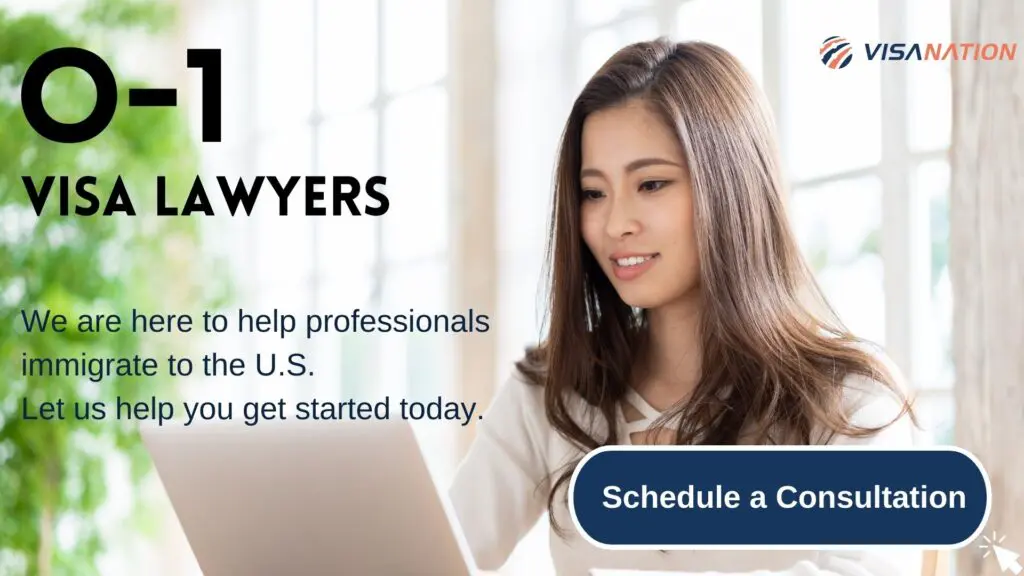If you are among the most prestigious experts in your field in the area of science, art, education, business, athletics, or motion picture/television then you may qualify for the O-1 visa. While the requirements are very stringent, the O-1 visa affords many benefits to those who qualify. In this guide, we’ll take a look at all the filing fees associated with the O-1 so you can make a well-informed decision on whether it’s the right immigration path for you.
Your achievements set you apart. We’ll build the O-1 case that reflects your standing
Breakdown of O-1 Visa Government Filing Fees
Let’s start by breaking down the process to determine the O-1 processing fees that each step requires. Here are the mandatory O-1 visa fees:
Form I-129 Petition Fee:
The basic filing fee for the O-1 visa is $1,055. There is a reduced fee of $530 for small employers/nonprofits.
Form DS-160 Filing Fee:
The DS-160 filing fee is $205.
This fee is due after the O-1 petition approval. It is owed to the U.S. Department of State for processing the nonimmigrant visa application. To pay, you log on to the CEAC portal.
Premium Processing (optional)
USCIS offers a special service called premium processing for $2,805. This shortens the processing time of the I-129 petition to 15 business days.
O-1 Visa Attorney Fees
The attorney fee to file an O-1 visa from the VisaNation Legal team is $5,500. View our fees.
Additional Considerations
Along with the mandatory O-1 processing fees, auxiliary costs associated with the visa include:
- Travel Costs: Travel to the U.S. embassy or consulate, as well as traveling to the U.S. after visa approval
- Family: If you plan to bring your spouse or children to the U.S., each will need to file separate DS-160 filing fees. An I-539 form must be used when it’s time to extend their status, costing $420 online or $470 for paper filing.
Can I Get a Refund on My O-1 Visa Fees?
USCIS typically does not offer refunds unless a mistake has been made. There are a few specific scenarios in which someone can expect an O-1 processing fee refund:
- If the USCIS has asked you for an unnecessary form that requires a fee.
- If the USCIS has asked for a fee payment greater than stated on their website.
- If the USCIS fails to process your I-129 petition within 15 business days after the premium processing fee has been paid.
How to Pay Your O-1 Visa Fees
The USCIS requires that you pay the O-1 processing fees through one of the following:
- a money order
- a cashier’s check
- personal check
- pay by credit card or debit card using Form G-1450, Authorization for Credit Card Transactions.
For those paying with a check, make it payable to the U.S. Department of Homeland Security.
It is generally recommended that each payment be separated into individual checks or money orders, as adding them together could cause difficulties. Speak with your immigration attorney to determine the best strategy for paying your O-1 processing fees.
Start your U.S. career with confidence. We’ll handle the complexities
O-1 Extension Fees
To extend or renew your visa, the petitioner is responsible for filing a new I-129 petition, costing $1,055 (or $530 for small employers/nonprofits). For any dependents, the extension/renewal using Form I-539 costs $420 (or $470 for paper filing)
The extension application should also include the following documentation:
- A copy of your arrival/departure form I-94
- A written statement detailing why the extension is necessary
- An I-539 form and a filing fee of $420 (or $470 for paper filing) if your spouse or dependents want to renew their visas as well.
A great advantage of the O-1 visa is the ability to extend it indefinitely, provided that the work that brought you into the U.S. has not been completed.
O-1 Visa Processing Time in 2026
You may also be wondering how long your O-1 visa will take to process from start to finish:
- The I-129 petition takes an average of three to four months to process. This, however, is heavily dependent on your service center’s caseload. Using premium processing will shorten this processing time to 15 business days.
- The best way to get an accurate gauge of the processing time is to use this USCIS tool. First select I-129 under the Form field, then select O under the Form Category field, and then the specific field office or service center handling your application.
- Consider the amount of time it will take to gather and organize the evidence required to prove your eligibility for the O-1 visa.
- If you are outside the U.S. and must undergo consular processing. The O-1 processing time may be extended depending on appointment availability at your nearest consulate or embassy.
If you have additional questions about your case, your first point of contact should be your immigration attorney. Another option is to use the USCIS case processing times tool. To use this, put in your receipt date, and it will tell you when you can inquire directly with USCIS about your case.

How to Choose an O-1 Visa Lawyer
Below are some key characteristics you should look for when choosing an O-1 lawyer. Use your discretion and always research to ensure they are a credible law firm.
- Experience and Specialization – Look for a lawyer who specializes in O-1 visa cases and has a proven track record of success.
- Education and Credentials – Check the lawyer’s credentials, such as their education, professional memberships, and certifications.
- Communication – Your lawyer should be responsive to your questions and be able to keep you updated about your case.
- Legal Fees – Look for lawyers who have transparent billing structures, and ensure you understand the costs involved.
- Personal Approach – A good lawyer will offer a personalized approach and take the time to understand your unique situation and goals.
Transparent pricing for comprehensive support. No surprises, just results.
Frequently Asked Questions
How Much Does An O-1 Visa Lawyer Cost?
An O-1 Visa lawyer typically costs between $5,000-$15,000. This does not include the standard government filing fees associated with the O-1 Visa.
Can I Change Employers on an O-1 Visa?
To transfer your O-1 status to a new employer, you must have the new employer file a new I-129 petition along with the O-1 processing fee of $1,055 (or $530 for small employers/nonprofits)
How does it compare in terms of processing time to the H-1B visa?
Typically, the processing time for the O-1 visa is quicker compared to other visas, such as the H-1B visa. However, it is advisable to allow a timeframe of three to four months for the application to be processed. Since the processing time for the I-129 petition depends on the specific service center handling it, it can be challenging to determine the exact duration to anticipate.
Check out this O-1 Visa vs EB-1 Green Card Guide.
Can I change my status to permanent residency with the O-1?
In certain situations, individuals holding O-1 visa status may decide to apply for a change of status (COS) to a different non-immigrant status or even pursue permanent residency.
The O-1 visa classification is considered to have “dual intent,” which means that, unlike other work visas, you can pursue a green card while being on O-1 status.
If you are currently in the United States and wish to change your status, you must have been legally admitted into the country on a non-immigrant status, should not have committed any crimes or engaged in activities that would make you ineligible for immigration benefits, there should be no outstanding circumstances that require you to leave the country before changing your visa category and you will need to submit a change of status application before the expiration date of your I-94 document.
What are the advantages of an O-1 visa over other work visas?
One significant benefit is that there is no annual quota imposed on O-1 visas. In contrast to the H-1B, which has an annual quota of 65,000 in the regular cap and an additional 20,000 in the master’s exemption, this is a substantial advantage. Another benefit is the ability to extend the O-1 visa in one-year increments after the initial three-year period. These extensions can be granted indefinitely, provided that the visa holder maintains their nonimmigrant status and can demonstrate that an extended stay in the U.S. is necessary to complete the work for which they were initially granted the visa.
How do I get an O-1 sponsor?
Typically, there are two types of sponsors for the O-1 visa: an employer and an agent. An employer is a company or individual for whom the applicant will work or provide services. On the other hand, an agent is hired to represent the applicant’s skills and help them find suitable employment. The sponsor, regardless of being an employer or an agent, must provide three essential components on behalf of the applicant:
- Information: This includes details such as the sponsor’s name, address, tax ID number, gross income, net income, number of employees, and other relevant information.
- A signed petition: The sponsor needs to submit a petition requesting work status for the individual.
- Good faith: The sponsor must demonstrate a genuine intention to collaborate with the applicant in the suggested manner.
What if my O-1 visa extension was denied?
Some common reasons for an O-1 visa extension denial or rejection are:
- You no longer work in the capacity that earned you the O-1 visa in the first place.
- The USCIS has determined that the project you were working on no longer requires your presence to be successfully completed.
- You have in some way violated your O-1 status.
- There is an error or omission in your petition.
- Your fees were inadequate or incorrectly filed.
If you’ve been denied, your first call should be to your immigration attorney, who will be better able to gauge the next step. Some avenues include filing a motion to reopen, a motion to reconsider, or trying a different visa classification path altogether. Whatever you do, do not become confrontational with USCIS officials or attempt to bribe them in any way. Some common alternative green cards that O-1 visa holders choose are the EB-1A, EB-1B, and EB-2.











